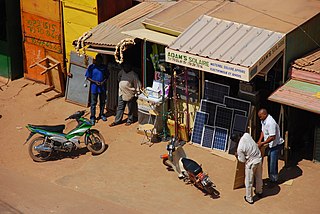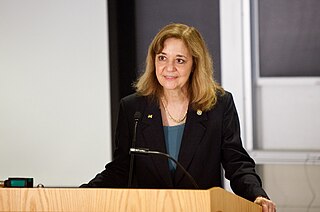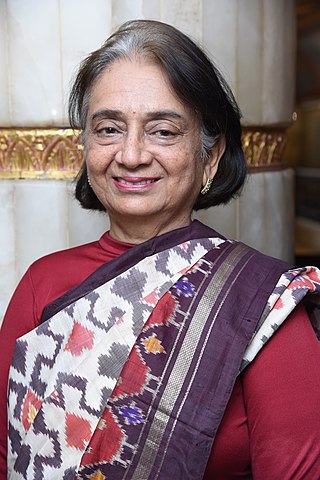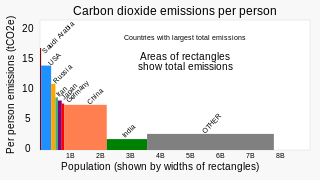Robert Dixon | |
|---|---|
 |
Robert K. Dixon is an energy, environment, and economic expert at the Office of International Affairs, US Department of Energy headquarters in Washington, DC, USA.
Robert Dixon | |
|---|---|
 |
Robert K. Dixon is an energy, environment, and economic expert at the Office of International Affairs, US Department of Energy headquarters in Washington, DC, USA.
Dixon is a native of Lee's Summit, Missouri. He graduated from Lee's Summit High School in 1973, [1] and attended the University of Missouri, earning his Bachelor of Science in 1977, Master of Science in 1979, and Ph.D. in 1982.
Early in his professional life, he was a professor at the University of Minnesota (1982 to 1986) and Auburn University (1987 to 1989). [2]
Dixon is married to Anita L. Dixon, and has two children: Caitlin S. Dixon and Colin A. Dixon.
He has been an adjunct and visiting professor, guest lecturer, [2] executive in residence, [3] and member of the university advisory boards at West Virginia University (2010 to 2012). He is currently an adjunct professor at American University in Washington, DC.
He led an industrial chemistry research and development program sponsored by Allied Chemical Corporation (1979 to 1982) and co-authored a U.S. patent [4] for fertilizer formulation and applications (1988). He was a principal scientific advisor to, and startup investor in, Mycorr Tech, Inc. (1986 to 1989), a biotechnology firm subsequently acquired by Plant Health Care, Inc.
Dixon is editor-in-chief of the international scientific journal, Mitigation and Adaptation Strategies for Global Change since 1997. [5] He was Guest Editor of Climatic Change [6] and Energy Policy [7] and currently serves on the CRC Press Sustainable Energy Development Editorial Board. [8] He has authored, co-authored, or edited more than 125 journal articles and several books on energy and environment science and policy topics, such as Adapting to Climate Change: An International Perspective [9] , The U.N. Framework Convention on Climate Change Activities Implemented Jointly (AIJ) Pilot: Experiences and Lessons Learned, [10] Energy Technology Perspectives, Scenarios and Strategies to 2050, [11] and others. [12] [13] [14] [15]
For nearly three decades, Dixon has led U.S. government energy and environment science, technology and policy programs at three federal agencies:
Dixon has worked with organizations across the globe, [18] and for Presidential councils and executive offices. [19] He led two Presidential Initiatives (1992 to 1997), the U.S. Country Studies Program, [20] and the Initiative on Joint Implementation. [21]
During the Administration of President G.W. Bush, Dixon served as Senior Director, White House Task Force on Energy Security and Climate Change (2007 to 2008), [2] jointly implemented by the U.S. Council on Environmental Quality (CEQ) and the National Security Council. He was a key contributor to the G-20 Major Economies Process and deliberations on the Energy Security Act of 2007. He was Associate Director at the CEQ (2004 to 2005) [16] and professional staff in the Office of Science and Technology Policy (1986 to 1987). [22]
Dixon was founding Executive Director, Secretariat for the International Partnership for the Hydrogen Economy (2003 to 2004) [23]
At the International Energy Agency (2005 to 2007) of the Organisation for Economic Co-operation and Development, he was Head of Energy Technology Policy Division, [24] strategizing and directing technology policy analyses for clients such as the G-20 Heads of State.
For the Global Environment Facility of The World Bank Group, Dixon was Team Leader for Climate Change and Chemicals (2008 to 2015), [25] overseeing a multibillion-dollar portfolio of energy, environment, public health, infrastructure, and transportation projects in developing and transition countries.
Dixon has been a delegate to intergovernmental negotiating committees and subsidiary bodies of the United Nations Framework Convention on Climate Change (1992 to present), [26] Montreal Protocol on Substances that Deplete the Ozone Layer (1989 to present), [27] Minamata Convention on Mercury (2009 to 2015), [28] the Asia-Pacific Partnership on Clean Development and Climate (2006 to 2011), the Stockholm Convention on Persistent Organic Pollutants (2004 to 2015), [29] and United Nations Conference on Environment and Development (1992).
Dixon was a member of the United Nations Transitional Committee for the Green Climate Fund (2009 to 2012), advisor to the U.S. National Academy of Sciences and National Academy of Engineering (2002 to present) on energy and environmental projects, delegate to the Renewable Energy Policy Network for the 21st Century (REN21) (2004 to 2013), [30] Commissioner General of the China World EXPO 2010 “Better City, Better Life" (2010), [31] and Vice Chairman of the IEA Working Party on Renewable Energy Technologies (2001 to 2004).
He has briefed and testified before committees of the U.S. House of Representatives and U.S. Senate (1999 to present) on a wide variety of energy science and research issues, including U.S. energy technology transfer [32] and climate change and technology policy options. [33]
Dixon has been a strategic and tactical advisor aiding in the implementation of energy, environmental, and economic development and transition programs worldwide for Catholic Relief Services (1988), the Open Society Foundation (1994), the International Foundation for Science (1993 to 1998), [16] [34] CARE [34] [16] (1988), and others.

Renewable energy, green energy, or low-carbon energy is energy from renewable resources that are naturally replenished on a human timescale. Renewable resources include sunlight, wind, the movement of water, and geothermal heat. Although most renewable energy sources are sustainable, some are not. For example, some biomass sources are considered unsustainable at current rates of exploitation. Renewable energy is often used for electricity generation, heating and cooling. Renewable energy projects are typically large-scale, but they are also suited to rural and remote areas and developing countries, where energy is often crucial in human development.

The United Nations Environment Programme (UNEP) is responsible for coordinating responses to environmental issues within the United Nations system. It was established by Maurice Strong, its first director, after the United Nations Conference on the Human Environment in Stockholm in June 1972. Its mandate is to provide leadership, deliver science and develop solutions on a wide range of issues, including climate change, the management of marine and terrestrial ecosystems, and green economic development. The organization also develops international environmental agreements; publishes and promotes environmental science and helps national governments achieve environmental targets.

The Global Environment Facility (GEF) is a multilateral environmental fund that provides grants and blended finance for projects related to biodiversity, climate change, international waters, land degradation, persistent organic pollutants (POPs), mercury, sustainable forest management, food security, and sustainable cities in developing countries. It is the largest source of multilateral funding for biodiversity globally, and distributes more than $1 billion a year on average to address inter-related environmental challenges.

Energy is sustainable if it "meets the needs of the present without compromising the ability of future generations to meet their own needs." Most definitions of sustainable energy include considerations of environmental aspects such as greenhouse gas emissions and social and economic aspects such as energy poverty. Renewable energy sources such as wind, hydroelectric power, solar, and geothermal energy are generally far more sustainable than fossil fuel sources. However, some renewable energy projects, such as the clearing of forests to produce biofuels, can cause severe environmental damage.

Energy policy is the manner in which a given entity has decided to address issues of energy development including energy conversion, distribution and use as well as reduction of greenhouse gas emissions in order to contribute to climate change mitigation. The attributes of energy policy may include legislation, international treaties, incentives to investment, guidelines for energy conservation, taxation and other public policy techniques. Energy is a core component of modern economies. A functioning economy requires not only labor and capital but also energy, for manufacturing processes, transportation, communication, agriculture, and more. Energy planning is more detailed than energy policy.

REN21 is a think tank and a multistakeholder governance group which is focused on renewable energy policy.
reegle (lower-case) was a search engine specifically covering the fields of renewable energy, efficient energy use, and climate change issues. It was developed in 2005 by REEEP and REN21, with funding from several European government agencies. At one point, it had 220,000 visitors per month.

A low-carbon economy (LCE) or decarbonised economy is a concept for a desirable economy which has relatively low greenhouse gas (GHG) emissions per person. GHG emissions due to human activity are the dominant cause of observed climate change since the mid-20th century. There are many strategies and approaches for moving to a low-carbon economy, such as encouraging renewable energy transition, efficient energy use, energy conservation, electrification of transportation, carbon capture and storage, climate-smart agriculture. An even more ambitious target than low-carbon economies are zero-carbon economies with net zero emissions. An example are zero-carbon cities.

Renewable energy commercialization involves the deployment of three generations of renewable energy technologies dating back more than 100 years. First-generation technologies, which are already mature and economically competitive, include biomass, hydroelectricity, geothermal power and heat. Second-generation technologies are market-ready and are being deployed at the present time; they include solar heating, photovoltaics, wind power, solar thermal power stations, and modern forms of bioenergy. Third-generation technologies require continued R&D efforts in order to make large contributions on a global scale and include advanced biomass gasification, hot-dry-rock geothermal power, and ocean energy. In 2019, nearly 75% of new installed electricity generation capacity used renewable energy and the International Energy Agency (IEA) has predicted that by 2025, renewable capacity will meet 35% of global power generation.

The renewable-energy industry is the part of the energy industry focusing on new and appropriate renewable energy technologies. Investors worldwide have paid greater attention to this emerging industry in recent years. In many cases, this has translated into rapid renewable energy commercialization and considerable industry expansion. The wind power, solar power and hydroelectric power industries provide good examples of this.

Renewable energy in developing countries is an increasingly used alternative to fossil fuel energy, as these countries scale up their energy supplies and address energy poverty. Renewable energy technology was once seen as unaffordable for developing countries. However, since 2015, investment in non-hydro renewable energy has been higher in developing countries than in developed countries, and comprised 54% of global renewable energy investment in 2019. The International Energy Agency forecasts that renewable energy will provide the majority of energy supply growth through 2030 in Africa and Central and South America, and 42% of supply growth in China.

100% renewable energy is the goal of the use renewable resources for all energy. 100% renewable energy for electricity, heating, cooling and transport is motivated by climate change, pollution and other environmental issues, as well as economic and energy security concerns. Shifting the total global primary energy supply to renewable sources requires a transition of the energy system, since most of today's energy is derived from non-renewable fossil fuels.

Green growth is a concept in economic theory and policymaking used to describe paths of economic growth that are environmentally sustainable. It is based on the understanding that as long as economic growth remains a predominant goal, a decoupling of economic growth from resource use and adverse environmental impacts is required. As such, green growth is closely related to the concepts of green economy and low-carbon or sustainable development. A main driver for green growth is the transition towards sustainable energy systems. Advocates of green growth policies argue that well-implemented green policies can create opportunities for employment in sectors such as renewable energy, green agriculture, or sustainable forestry.
Environmental governance (EG) consists of a system of laws, norms, rules, policies and practices that dictate how the board members of an environment related regulatory body should manage and oversee the affairs of any environment related regulatory body which is responsible for ensuring sustainability (sustainable development) and manage all human activities—political, social and economic. Environmental governance includes government, business and civil society, and emphasizes whole system management. To capture this diverse range of elements, environmental governance often employs alternative systems of governance, for example watershed-based management. Obviously, in fact the EG arrangements are very diversed and not at all as inclusive as we could wish them to be.

Rosina M. Bierbaum is currently the Roy F. Westin Chair in Natural Economics and Research Professor at the University of Maryland's School of Public Policy. She is also a professor and former dean at the University of Michigan School of Natural Resources and Environment (SNRE). She was hired in October 2001, by then-University of Michigan President, Lee Bollinger. She is also the current Chair of The Scientific and Technical Advisory Panel (STAP) that provides independent scientific and technical advice to the GEF on its policies, strategies, programs, and projects.

Jyoti Kirit Parikh is the current Executive Director of Integrated Research and Action for Development (IRADe). She was a Member of the Prime Minister’s Council on Climate Change –India and is a recipient of Nobel Peace Prize awarded To IPCC authors in 2007. She was a Senior Professor at Indira Gandhi Institute of Development Research (IGIDR), Mumbai. She also worked at the International Institute for Applied Systems Analysis (IIASA), Austria and served as a senior energy consultant at the National Institution for Transforming India (1978–80). She was a visiting professor at the Institute of Advanced Studies (IAS) of UNU, Tokyo (1995–96). She was the Acting Director of IGIDR for 1997-98. She has experience for nearly thirty years on energy and environment problems of the developing countries.
The Scientific and Technical Advisory Panel (STAP) is an independent advisory body established by the United Nations Global Environment Facility (GEF) in 1995. Seven expert advisers provide the GEF with up to date, authoritative and globally representative science in the areas of biological diversity, climate change, desertification and persistent organic pollutants.

Martha Rojas Urrego is a biologist, ecologist and humanitarian, gender and environmental advocate. She is a Colombian and French national. In August 2016 she was appointed as the Secretary General of the Ramsar Convention on Wetlands. Previously she was Head of Global Advocacy and Acting Deputy Secretary General at humanitarian organization CARE International.

China's greenhouse gas emissions are the largest of any country in the world both in production and consumption terms, and stem mainly from coal burning, including coal power, coal mining, and blast furnaces producing iron and steel. When measuring production-based emissions, China emitted over 14 gigatonnes (Gt) CO2eq of greenhouse gases in 2019, 27% of the world total. When measuring in consumption-based terms, which adds emissions associated with imported goods and extracts those associated with exported goods, China accounts for 13 gigatonnes (Gt) or 25% of global emissions.
{{cite book}}: |journal= ignored (help)In 2007-2008 he was Senior Coordinator, White House Task Force on Energy Security and Climate Change, National Security Council, Executive Office of the U.S. President, in 2007-2008. Dr. Dixon was responsible for the Major Economies Climate Change Negotiation Process and contributor to the 2007 Energy Security Act.
{{cite journal}}: CS1 maint: DOI inactive as of January 2024 (link)Dr. Robert K. Dixon - Head, Energy Technology Policy Division
The GEF was closely involved in the preparation of the EXPO, with the head of the GEF's Climate change and Chemicals team, Robert Dixon, having been selected as Commissioner General of the EXPO.
Dixon serves as an advisor to the International Foundation for Science and a consultant to the Soros Foundation, CARE and other organizations.
He was awarded a Smithsonian Fellowship in 1985 to evaluate natural resource and renewable energy development projects in India, Pakistan and Nepal.